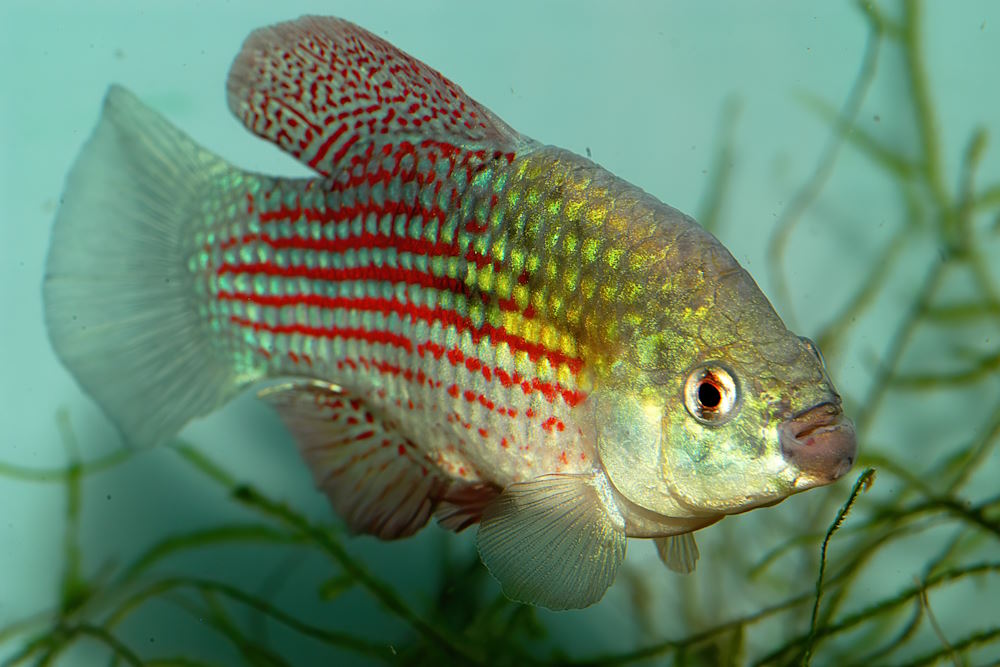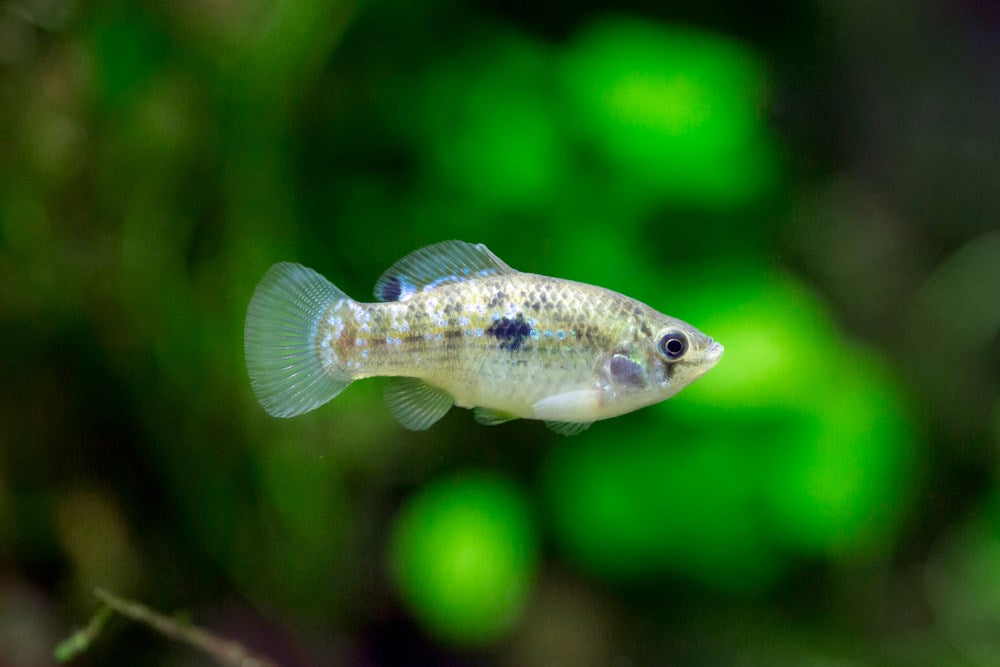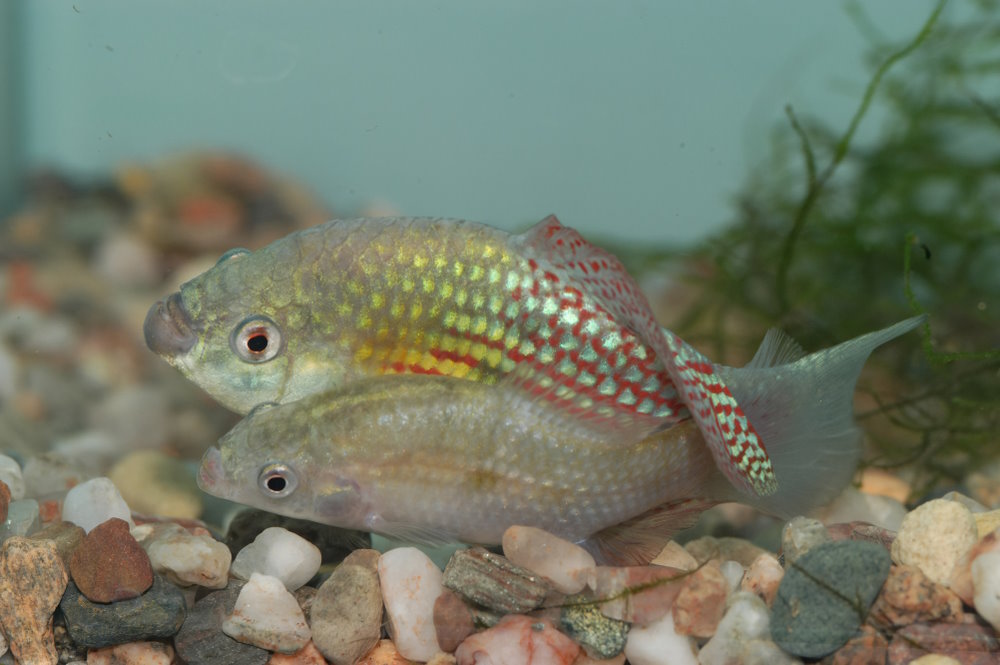Care Guide for American Flagfish — Algae Eater for Unheated Aquariums
The American flagfish (or Florida flagfish) is one of the few native fish from the United States that is available in the aquarium trade. Because of their beautiful colors and algae-eating appetite, many fishkeepers keep them as clean-up crew members for their unheated aquariums and outdoor ponds. In fact, we personally use them in our plant-holding tanks at the Aquarium Co-Op fish store and warehouse to keep the leaves free of algae. Learn how to care for, feed, and breed this lively species from the state of Florida.
What is the Florida Flagfish?
Jordanella floridae is a 2- to 2.5-inch (5–6 cm) North American pupfish, or type of killifish. It is not an annual killifish, meaning that it lives longer than one year and does not need to be immediately bred to maintain the population. Its common name comes from the male’s unique coloration — rows of red and blue horizontal striping with a yellow shoulder patch — that looks like the stars and stripes of the United States flag. The female, on the other hand, is smaller, less colorful, and has a rounder abdomen when carrying eggs. Both sexes display a prominent black spot on the sides of their bodies, but females often have another small black dot on the back edge of the dorsal fin. Personality-wise, they are very active and constantly dart around looking for algae and other leftover crumbs to eat. Their mouths are perfectly shaped for ripping off hair algae, black beard algae, and other fuzzy types of algae.

Male flagfish
How to Set Up an Aquarium for Flagfish
In the wild, they come from swampy Floridian marshes that are full of vegetation and consist of harder water or mildly brackish water. However, they are extremely hardy and can handle a wide range of parameters from pH of 6.5–8.5, soft to hard water, and 64–86°F (18–30°C). As a North America species, flagfish can thrive in unheated aquariums that have a tight-fitting lid to prevent escape. Some people put them in outdoor mini ponds during the summer to help eat algae and mosquito larvae.
Are flagfish schooling fish? Similar to dwarf cichlids, males can be quite territorial towards one another, whereas females tend to be more docile. Therefore, we recommend getting a ratio of one male for every two to three females. A pair of flagfish can live in a 20-gallon aquarium, but you should increase the tank size for each additional male so that they can each establish their own space.
Are flagfish safe with aquarium plants? To reduce fighting among the fish, we usually recommend getting lots of live aquatic plants to help block line of sight. However, in their eagerness to eat algae, flagfish can sometimes accidentally tear up more delicate plant leaves. We’ve had good luck putting them with tougher plants like java fern, fast-growing plants, and java moss for breeding purposes. Some hobbyists recommend keeping them well-fed to minimize any nibbling on leaves.
What fish can live with flagfish? Because of their feisty personalities, we recommend keeping them with other fast-swimming, boisterous tank mates that are similar in size. Zebra danios, corydoras catfish, loaches, and livebearers have all gotten along well with our flagfish. However, they are likely to predate on dwarf shrimp like cherry shrimp and ghost shrimp.

Female flagfish with black dot on dorsal fin
What Do Flagfish Eat?
As omnivores, they enjoy both meaty foods and plant matter — such as freshwater plankton, small crustaceans, insect larvae, and algae. They are not picky eaters and will readily take pellets, freeze-dried foods, frozen foods, and live foods. Because of their love of algae, make sure to add vegetables and other greenery to their diet, like spirulina flakes, Repashy Soilent Green gel food, and blanched (or lightly boiled) zucchini slices.
How to Breed Flagfish
Flagfish are not too difficult to breed and tend to spawn during the spring and summer seasons when the water is warmer. Mating behavior consists of nipping and chasing until the pair embrace and the female releases her eggs over the course of several days. Provide DIY spawning mops, java moss, and other dense foliage to serve as spawning sites and extra cover to hide the newborns.
Some biologists have reported that the male exhibits parental care by chasing away intruders from the spawning site, fanning the eggs to increase water flow and oxygenation, and eating any eggs that become infected with fungus. However, breeders often remove the eggs into a separate hatching bin to increase the yield and prevent predation. Depending on the water temperature, the eggs may hatch within a week or two. Once the newborns are free-swimming, feed them several small meals each day consisting of live vinegar eels and powdered fry food until they’re big enough to eat live baby brine shrimp and micro worms.

Spawning behavior with male and female flagfish
The Florida flagfish is such a gorgeous and useful species that everyone should try out at least once. If you’re looking for a whole team of different algae eaters to help you clean up your planted aquarium, read our article on the 10 Best Algae Eaters for Freshwater Aquariums.




